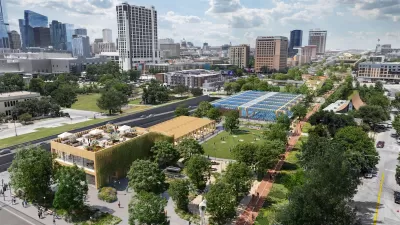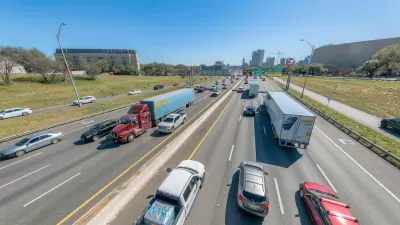In addition to new HOV lanes and a proposed boardwalk, TxDOT agreed to engineer the freeway for caps in some areas, but the city would have to fund their construction.

A letter sent by Austin mayor Kirk Watson to opponents of a freeway widening project outlines proposed changes to the Texas Department of Transportation (TxDOT)’s Interstate 35 expansion plan, which is being opposed by resident groups and some local officials.
According to an article by Nathan Bernier for KUT, “Adjustments to the once-in-a-generation project include the possibility of covering larger sections of the highway north of downtown, constructing a $25 million boardwalk on Lady Bird Lake and filtering stormwater runoff into the Colorado River.”
Bernier adds, “TxDOT's transformation plans include lowering the main lanes for much of the distance between Oltorf Street and Airport Boulevard. The City of Austin hopes to cover these lowered portions of the highway with "caps" — basically large decks — that could support buildings at least two stories tall. TxDOT won't pay for the caps, but will engineer the highway to allow for their installation.” The agency has agreed to lower a third portion to make way for a cap.
As part of the project, “TxDOT is set to construct a near half-billion-dollar drainage system, which includes a tunnel under Cesar Chavez Street that would direct stormwater runoff into the Colorado River near U.S. 183.” But according to the city’s Watershed Protection Department, “The current design would not have the capacity to treat all stormwater runoff.”
The article details other parts of the TxDOT plan, such as new high occupancy vehicle (HOV) lanes and the $25 million boardwalk along Lady Bird Lake that would replace other parkland that will be lost to the project. The expansion has faced staunch opposition from local residents, including three city council members, from the start.
FULL STORY: Austin's I-35 plans revised to include new cap and a $25 million boardwalk

Study: Maui’s Plan to Convert Vacation Rentals to Long-Term Housing Could Cause Nearly $1 Billion Economic Loss
The plan would reduce visitor accommodation by 25,% resulting in 1,900 jobs lost.

North Texas Transit Leaders Tout Benefits of TOD for Growing Region
At a summit focused on transit-oriented development, policymakers discussed how North Texas’ expanded light rail system can serve as a tool for economic growth.

Why Should We Subsidize Public Transportation?
Many public transit agencies face financial stress due to rising costs, declining fare revenue, and declining subsidies. Transit advocates must provide a strong business case for increasing public transit funding.

How Community Science Connects People, Parks, and Biodiversity
Community science engages people of all backgrounds in documenting local biodiversity, strengthening connections to nature, and contributing to global efforts like the City Nature Challenge to build a more inclusive and resilient future.

Alabama: Trump Terminates Settlements for Black Communities Harmed By Raw Sewage
Trump deemed the landmark civil rights agreement “illegal DEI and environmental justice policy.”

Dear Tesla Driver: “It’s not You, It’s Him.”
Amidst a booming bumper sticker industry, one writer offers solace to those asking, “Does this car make me look fascist?”
Urban Design for Planners 1: Software Tools
This six-course series explores essential urban design concepts using open source software and equips planners with the tools they need to participate fully in the urban design process.
Planning for Universal Design
Learn the tools for implementing Universal Design in planning regulations.
City of Santa Clarita
Ascent Environmental
Institute for Housing and Urban Development Studies (IHS)
City of Grandview
Harvard GSD Executive Education
Toledo-Lucas County Plan Commissions
Salt Lake City
NYU Wagner Graduate School of Public Service





























